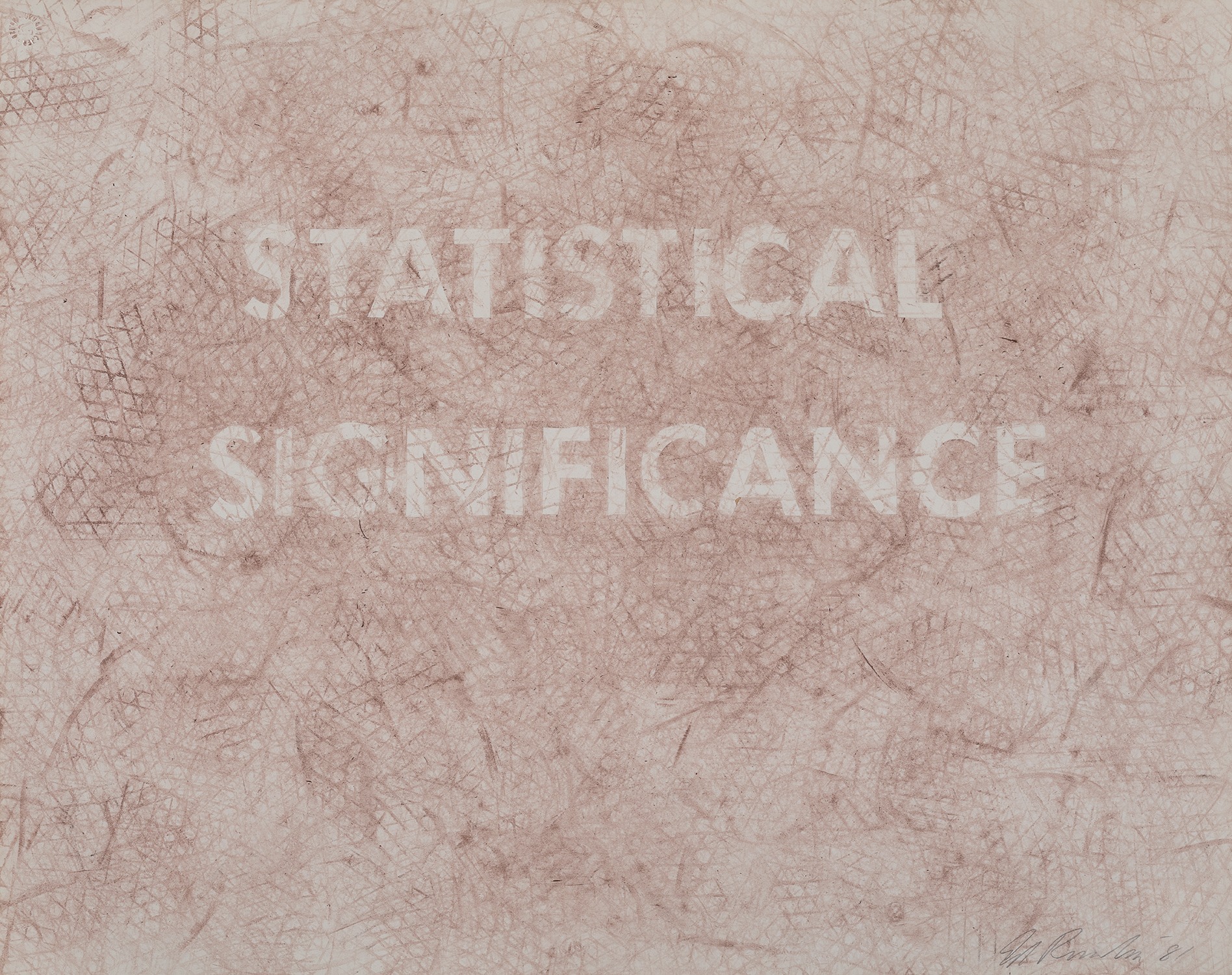

157Ο◆
Ed Ruscha
Statistical Significance
Full-Cataloguing
Freed from the constraints of oil painting, Ruscha began to experiment with various materials in 1965. In his 1969 portfolio Stains he rigorously explored the varying effects and qualities of materials, testing yellow pepper, egg yolk, sulphuric acid and gunpowder amongst others. The present work, executed over 10 years after the Stains portfolio, demonstrates Ruscha’s commitment to the medium of drawing. Turning away from traditional conventions, however, in Statistical Significance, Ruscha has distanced his artistic hand by rubbing onto a raised surface. This technique draws from an art historical tradition, tracing back to the automatism of Surrealism and the Duchampian concept of ‘chance’. Though on first appearance the soft marks of chalk may seem arbitrary, Ruscha intently and masterfully constructed the work to allow for the stencilled letters spelling Statistical Significance to float and oscillate between the foreground and background. Rejecting the narrowly prescribed modes of the then dominant artistic traditions of Abstract Expressionism and Pop Art, Ruscha pioneered both his own visual vocabulary and innovative techniques to communicate this language.
Whilst Ruscha’s techniques and materials vary across media, the medium of language has remained a continuous thread throughout his career. When interviewed in 1973, Ruscha stated ‘I love the language. Words have temperatures to me. When they reach a certain point and become hot words, then they appeal to me’ (Ed Ruscha, quoted in Howardena Pindell, ‘Words with Ruscha', in The Print Collector’s Newsletter, vol. 3, no. 6, January - February 1973, p. 126). Sliding across the boundaries of Conceptual and Pop Art, Ruscha’s words signify his interest in vernacular culture and his continuous observation of the cultural landscape. In this way, Ruscha becomes a recorder of society’s ‘signs’, just as his photographic works recorded the physical Californian landscape. Ed Ruscha’s most iconic works are those in which imagery and semantic coexist to brilliantly engage with and probe the interplay between image, symbol and text as creators of meaning. Throughout his career Ruscha has masterfully selected poignant words, titles and sayings from popular culture to create often witty and ironic compositions. In the present work, Ruscha has swapped literary and cultural references for scientific language. ‘Statistical significance’ - the probability that a relationship between two variables is caused by a significant factor rather than chance, perhaps makes a conscious reference to the physical process of rubbing chalk, seemingly so haphazard yet in fact highly considered.
The ambiguity created by the gap between text and image lies at the heart of Ruscha’s artistic practice. Of his indeterminate style, Ruscha said: 'I like the idea that an artist should never be questioned about what he does, because he actually deserves this right of artistic license…I’ve always felt like the number one rule is that there are no rules' (Ed Ruscha, quoted in, Cotton Puffs, Q-Tips, Smoke and Mirrors: The Drawings of Ed Ruscha, exh. cat., Museum of Contemporary Art, Los Angeles, 2005, p. 154). It is this playful and cryptic sentiment that continues to enrich the viewer’s experience of Ruscha’s works.
Ed Ruscha
American | 1937Quintessentially American, Ed Ruscha is an L.A.-based artist whose art, like California itself, is both geographically rooted and a metaphor for an American state of mind. Ruscha is a deft creator of photography, film, painting, drawing, prints and artist books, whose works are simultaneously unexpected and familiar, both ironic and sincere.
His most iconic works are at turns poetic and deadpan, epigrammatic text with nods to advertising copy, juxtaposed with imagery that is either cinematic and sublime or seemingly wry documentary. Whether the subject is his iconic Standard Gas Station or the Hollywood Sign, a parking lot or highway, his works are a distillation of American idealism, echoing the expansive Western landscape and optimism unique to postwar America.